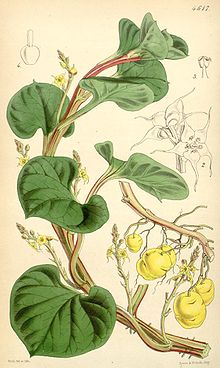User:Bauerf
| Ulluco | |
|---|---|

| |
| Scientific classification | |
| Kingdom: | |
| (unranked): | |
| (unranked): | |
| (unranked): | |
| Order: | |
| Family: | |
| Genus: | |
| Species: | U. tuberosus
|
| Binomial name | |
| Ullucus tuberosus Caldas
| |
Ulluco (Ullucus tuberosus) is a plant grown primarily as a root vegetable, secondarily as a leaf vegetable. Ulluco is an erect and compact plant which is 20-50 cm high. Its tubers vary in shape and color. The tubers can take every shape between spherical and cylindrical. The colors are manifold and can be white, light green, pink, orange and purple. [1]
The ulluco is one of the most widely grown and economically important root crops in the Andean region of South America, second only to the potato. The name Ulluco stems from the Quechua word ulluko, where ullu means male organ.[2] It is known there with the common name of papa lisa, but also by the regional names melloco (Ecuador), olluco (Peru), chugua (Colombia) or ruba (Venezuela), among others [3]. The leaf and the tuber are edible, similar to spinach and the potato, respectively.
Product and use
[edit]The major appeal of the ulluco is its crisp texture which, like the jicama, remains even when cooked. Because of its high water content, the ulloco is not suitable for frying or baking but it can be cooked in many other ways like the potato. In the pickled form, it is added to hot sauces. It is a basic ingredient together with the cubio in the typical Colombian dish cocido boyacense. They are generally cut into thin strips. Oblong and thinly shaped, they grow to be only a few inches long. Varying in color, papalisa tubers may be orange/yellow in color with red/pink/purple freckles. In Bolivia, they grow to be very colorful and decorative, though with their sweet and unique flavor they are rarely used for decoration. When boiled or broiled they remain moist and the texture and flavor are very similar to the meat of the boiled peanut without the skin but unlike the boiled peanut becoming soft and mushy the olluco remains firm and almost crunchy.
Nutritional value
[edit]Ulluco is known to contain high levels of protein, calcium, and carotene. The tuber is also a good source of carbohydrates. Fresh ulluco contains about 85% water, 15% sugars and starches, 1-2% proteins, wherease the protein content varies considerably. Up to 15% of proteins in dry weight have been reported. The unusually high vitamin C content of Ulluco (23mg/100g fresh weight) has also to be mentioned.[4]
Cultivation
[edit]Ulluco is cultivated at the high altitudes (2'400-4'000 m) of the Andes from Venezuela to Argentina, where daylengths don't exceed 10-13.5 hours. Ulluco is drought and cold resistant and well adapted to the predominant marginal soils. But the plant is also grown at sea level in Canada, England and Finland. [4]
The crop is cultivated in a similar way to potato, oca and mashua. Parts of the tuber or the shoot can be planted directly into the soil. No hormons or other treatments are necessary. A temperature of above 18 °C is ideal for the growth.[4] The tubers are planted in furrows with row spacing of 80-100 cm and distance of 40-50 cm. The planting density is recommended to be 450-675 kg/ha depending on the size of the tubers. Ulluco is normally planted during the rainy season and followed by potato as ullucos have a long vegetative period,[5] which lasts between 5 to 8 months depending on the varieties and the elevation. [4] But ulluco can also be intercropped with potato, mashua, quinoa or beans. It is not common to use fertilizer. Farmers however, sometimes add manure and harvest leftovers to improve the fertility of the soils. Between 6 and 12 t/ha are seen as a good dose. [5] The yield average is between 5 and 9 t/ha. [4]
Pests and diseases
[edit]Ulluco has few pest and disease problems. But it has been shown that the tubers are generally infected by viruses which decreases yield. Potential yield of virus free plants could be 30-50% more. [4]
See also
[edit]Notes
[edit]- ^ Ulluco tuberosus, Ecocrop
- ^ Fuccillo, D., Sears, L. & Stapleton, P. (eds.) Biodiversity in Trust, 1997, Cambridge University Press
- ^ Lost Crops of the Incas: Little-Known Plants of the Andes with Promise for Worldwide Cultivation, National Academies Press
- ^ a b c d e f Lost Crops of the Incas: Little-Known Plants of the Andes with Promise for Worldwide Cultivation, 1989, National Academies Press, Washington D.C.
- ^ a b Vimos, Carlos N., Nieto, Carlos C., Rivera, Marco M. El Melloco, Características, técnicas de cultivo y potencial en Ecuador, accessed March 30, 2011.
External links
[edit][[Category:Caryophyllales]] [[Category:Crops originating from Bolivia]] [[Category:Crops originating from Colombia]] [[Category:Crops originating from Ecuador]] [[Category:Crops originating from Peru]] [[Category:Root vegetables]] [[Category:Leaf vegetables]] [[ay:Ulluku]] [[cs:Melok hlíznatý]] [[de:Olluco]] [[es:Ullucus tuberosus]] [[fr:Ulluco]] [[it:Ullucus tuberosus]] [[lt:Gumbinis uliukas]] [[pt:Ullucus]] [[qu:Ulluku]] [[ru:Уллюко клубненосный]] [[fi:Ulluko]]
